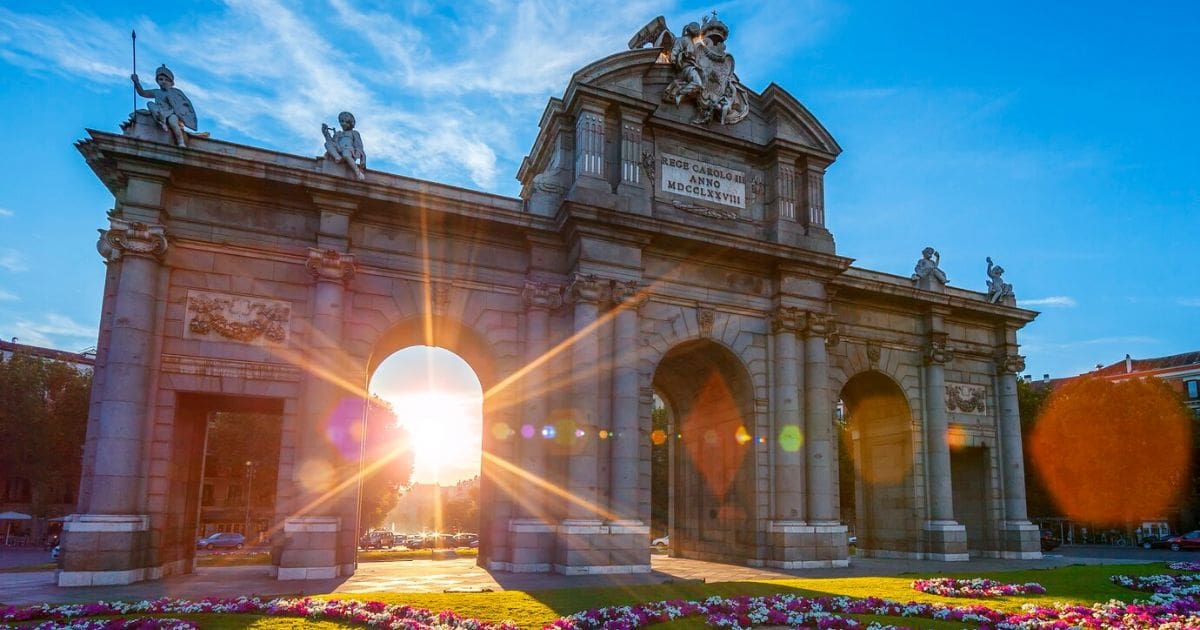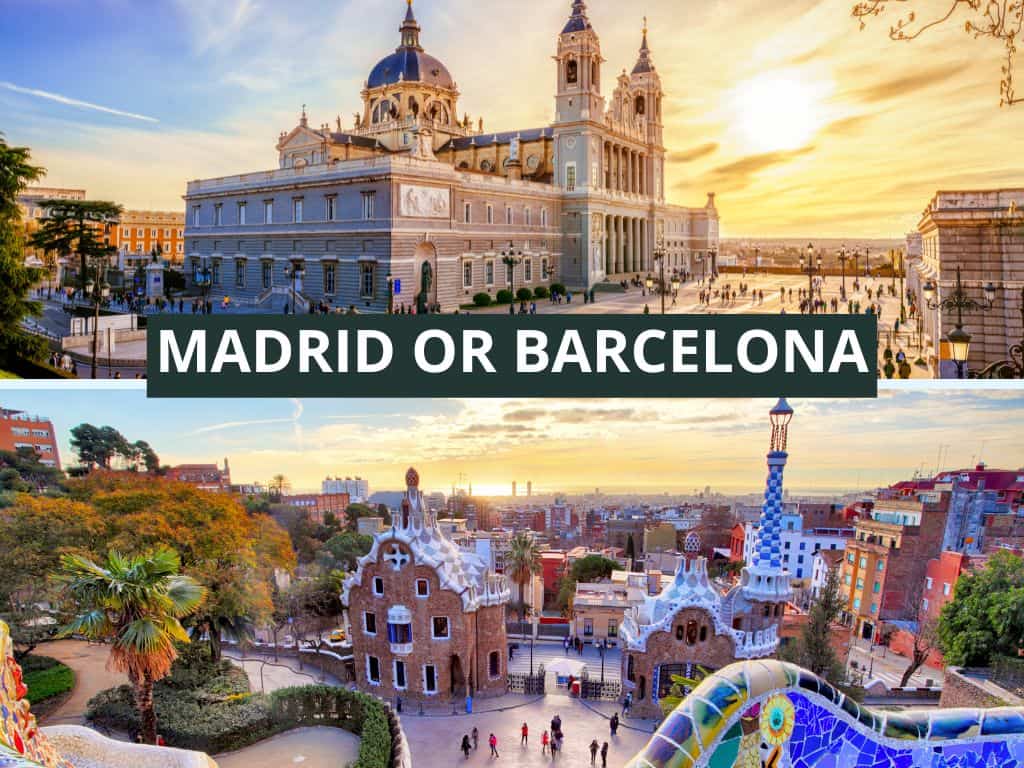For those considering a move to Spain, Madrid vs Barcelona often rise to the top of the list. As the two largest cities in the country, they each offer a high quality of life, with 350 days of sunshine per year, incredible food, world-class healthcare, vibrant nightlife, and rich culture.
While both are excellent choices, living in Madrid and Barcelona offers distinctly different lifestyles. Understanding the unique attributes of each city is key to deciding which is the ideal fit for you.
Size and Population
Madrid is significantly larger than Barcelona, both in geographic size and population. The metropolitan area of Madrid spans over 600 square kilometers compared to Barcelona’s 100 sq km. As of 2024, Madrid proper has 3.3 million residents, nearly double Barcelona’s 1.62 million. Including surrounding areas, the Madrid metro region contains 6.7 million people vs 5.7 million in greater Barcelona.
However, Barcelona is more densely populated, with 16,000 people per square km compared to 5,300 in Madrid. This means that despite its smaller size, Barcelona can feel more crowded, especially in central areas and during peak tourist season. A 2019 study by Ajuntament de Barcelona found that the city receives over 12 million tourists annually, leading to concerns about overtourism and strain on infrastructure.
Cost of Living
One of the biggest factors for most people considering a move is the cost of living. On this point, Madrid has the advantage. According to Numbeo’s Cost of Living Index, consumer prices, including rent, are around 3.7% higher in Barcelona than in Madrid. Expect to pay about 1.6% more for dining out in Barcelona as well.
Purchasing Power
Purchasing power is also 17.8% lower in Barcelona, meaning your Euros won’t stretch as far. Salaries tend to be higher in Madrid, with the average monthly net salary being €2,372.06 compared to €2,022.02 in Barcelona, per Numbeo’s data.
Rental Costs
Rental costs average around €1200-1300 per month for a one-bedroom apartment in desirable areas of either city center. Buying property is also very expensive, with prices over €4000 per square meter in prime Barcelona neighborhoods like Eixample and Gràcia and €3000-4000 in central Madrid districts like Salamanca and Chamberí, according to a 2023 report by Spanish real estate site Idealista. Utilities run €150-250 monthly, depending on apartment size.
Culture and Language
The beautiful city of Barcelona, located in the autonomous community of Catalonia, has a proudly unique regional identity. Catalan is co-official with Spanish and is widely spoken as a first language. Signs, menus, and public announcements are often in Catalan. So, basic knowledge can be very useful for feeling at home.
According to the Generalitat de Catalunya, as of 2021, 31.5% of Barcelona residents have Catalan as their habitual language and 55.1% can speak it. Meanwhile, Spanish is the predominant language of Madrid, Spain’s cosmopolitan capital.
This cultural contrast is also reflected in local festivals and traditions. Barcelona goes all out for its patron saint festival, La Mercè, every September with parades, human towers (castells), and citywide partying. Madrid honors its patron, San Isidro, in May with music, bullfights, and traditional dress.
Catalans also have their own unique holidays, like Sant Jordi’s Day, a charming festival held on April 23 to celebrate love and literature. During this festival, it’s customary to exchange books and roses. Both cities, though, take Christmas and Easter very seriously and celebrate them with elaborate celebrations.
Economy
Madrid has the edge in terms of career opportunities, being Spain’s financial and economic capital. It hosts the headquarters for many of Spain’s biggest companies and banks, such as Santander and BBVA, as well as offices for numerous multinationals.
According to Madrid’s Chamber of Commerce, the city is responsible for 20% of Spain’s total GDP. Barcelona’s economy is more diverse, with strengths in tourism, shipping via Europe’s ninth busiest container port, automotive manufacturing (SEAT is based there), pharmaceuticals, and fashion in addition to business services.
Barcelona is establishing itself as a tech hub with a thriving startup ecosystem. However, Madrid is further ahead in this sector, home to successful unicorns like Cabify and Glovo.
Employment
Hospitality and tourism are massive employers in Barcelona, even more so than in Madrid, which sees more business vs leisure visitors. The Barcelona Hotel Association reports that the city’s hotels employ over 15,000 people. Teaching English is a common job for expats in both cities, though wages are not high, averaging around €15-20 per hour.
Knowing Spanish is very helpful for most professional jobs; in Barcelona, knowledge of Catalan gives you an added advantage. The unemployment rate tends to be a couple of points lower in Madrid vs Barcelona historically, with rates of 10.6% and 12.5% respectively, as of early 2023 per INE (Spanish Statistical Office) data.
Climate and Beaches
Madrid’s climate is more of a weather rollercoaster compared to Barcelona’s milder Mediterranean conditions. Summers are scorching in Madrid, with temperatures regularly hitting 40°C (104°F) in July and August.
Meanwhile, 32-33°C is considered a major heat wave in more humid Barcelona. According to AEMET (the State Meteorological Agency), Madrid has an average of 2,769 hours of annual sunshine compared to Barcelona’s 2,524.
Winter Chills vs Year-Round Mild Temperatures
On the flip side, winters are chilly in Madrid, with temperatures dipping down to and even below freezing in December and January, sometimes accompanied by light snowfall. Barcelona rarely gets colder than 5°C (41°F) in winter.
Spring and autumn are generally very pleasant in both cities. They have comfortable temperatures and less rainfall than in winter, though Barcelona sees occasional heavy downpours in the fall.
Barcelona’s Beaches Give It a Big Edge
The biggest climatic difference, though, is Madrid’s lack of beaches – one of Barcelona’s top selling points. The Catalan capital’s string of beaches like Barceloneta, Mar Bella, and Bogatell are immensely popular travel destinations with locals and visitors, providing a breezy respite from the summer heat and crowds.
Madrid’s landlocked residents have to settle for the city’s many parks, like Retiro and Casa de Campo, or take day trips to escape the inferno-like conditions. A dip in the pool followed by a chilled clara con limón on a chiringuito beachfront bar is a classic Barcelona summer ritual.
Lifestyle and Leisure
Barcelona’s cosmopolitan yet laid-back, business-casual coastal ambiance contrasts with Madrid’s faster pace and more buttoned-up vibe. Life is lived later in Madrid, with dinner often starting at 9:00-10:00 pm and nightlife kicking into high gear past midnight.
Madrileños’ party stamina is legendary, with clubs pulsing till dawn. Both cities boast excellent and diverse dining and drinking scenes, but Barcelona’s buzzing beach chiringuito bars and rooftop terraces with Mediterranean views are hard to top.
Artistic Attractions: Prado and Gaudí
Culturally, Madrid is defined by its ‘Big Three’ art museums – the world-renowned Prado with its royal collections, the Reina Sofia with its modern masterpieces like Picasso’s Guernica, and the Thyssen-Bornemisza with its diverse historical panorama. Visitors queue for hours to marvel at iconic works in these hallowed halls.
Barcelona’s artistic icon, on the other hand, is Antoni Gaudí, whose surreal, nature-inspired modernist architecture dots the cityscape. Most famously, the unfinished Sagrada Família basilica and whimsical Parc Güell. The Picasso Museum, housing thousands of works from the artist’s youth, is another must-see in Barcelona.
Culture and Shopping Contrast
The vibrant Madrid, as the stately capital, has the upper hand in high culture, with a packed calendar of theater, classical music, opera, and dance performances in venues like the opulent Teatro Real. Barcelona, while no slouch culturally, has more of an edge in live music, especially during its famed Primavera Sound and Sónar festivals, drawing global acts and audiences, and in independent fashion and design.
Both cities have legendary football teams, Real Madrid and FC Barcelona, and their respective stadiums, the Bernabéu and Camp Nou, are pilgrimages for fans. The rivalry reaches a fever pitch during head-to-head El Clásico matches.
The heart of Madrid’s shopping is the Salamanca district, home to luxury boutiques and the designer ‘Golden Mile’ of Calle Serrano. More alternative fashion is found in the cool Malasaña zone.
Barcelona’s retail scene is defined by stylish international and independent brands in Passeig de Gràcia’s modernist flagship stores and the sprawling Diagonal Mar mall. Concept stores like Wer-Haus showcase cutting-edge local design.
Final Thoughts: Madrid vs Barcelona
In the end, there’s no definitively wrong choice between living in Madrid and Barcelona. It comes down to the unique characteristics you prioritize, from Madrid’s non-stop capital city energy to Barcelona’s blissful beachside Mediterranean lifestyle.
While the cultural contrast between Catalonia and wider Spain is significant, what the two leading cities share is more important—being world-class places to live, work, and study. By understanding the specifics of what each metropolis offers, you can make the exciting move to Madrid vs Barcelona with confidence and embark on the experience of a lifetime in your new Spanish home.



